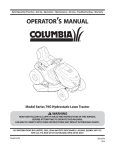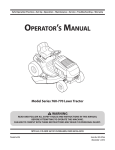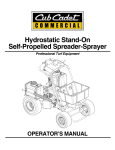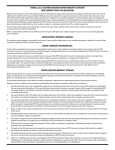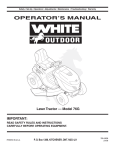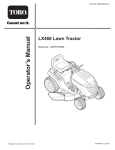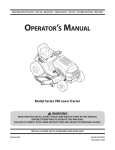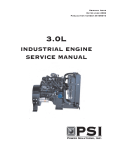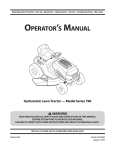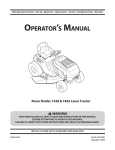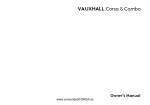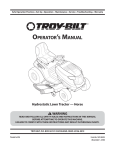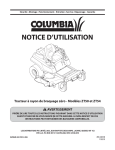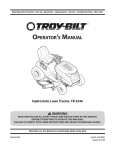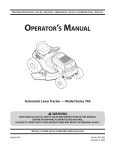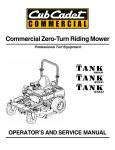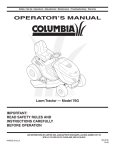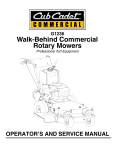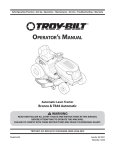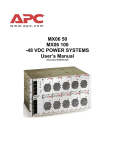Download White Outdoor Series 79G Operator`s manual
Transcript
4BGF0QFSBUJPO1SBDUJDFTt4FU6Qt0QFSBUJPOt.BJOUFOBODFt4FSWJDFt5SPVCMFTIPPUJOHt8BSSBOUZ OPERATOR’S MANUAL OUTDOO R .PEFM4FSJFT()ZESPTUBUJD-BXO5SBDUPS 8"3/*/( 3&"%"/%'0--08"--4"'&5:36-&4"/%*/4536$5*0/4*/5)*4."/6"#&'03&"55&.15*/(5001&3"5&5)*4."$)*/& '"*-63&50$0.1-:8*5)5)&4&*/4536$5*0/4.":3&46-5*/1&340/"-*/+63: 10#PY,FOU"WFOVF,*5$)&/&30/5"3*0$"/"%"/(+ Printed In USA 769-05994 3.8.10 1 To The Owner Thank You Thank you for purchasing your new equipment. It was carefully engineered to provide excellent performance when properly operated and maintained. The manufacturer reserves the right to change product specifications, designs and equipment without notice and without incurring obligation. 1MFBTFSFBEUIJTFOUJSFNBOVBMQSJPSUPPQFSBUJOHUIFFRVJQNFOU It instructs you how to safely and easily set up, operate and NBJOUBJOZPVSNBDIJOF1MFBTFCFTVSFUIBUZPVBOEBOZPUIFS persons who will operate the machine, carefully follow the recommended safety practices at all times. Failure to do so could result in personal injury or property damage. If you have any problems or questions concerning the machine, phone your local service dealer or contact us directly. Customer Support telephone numbers, website address and mailing address can be found on this page. We want to ensure your complete satisfaction at all times. "MMJOGPSNBUJPOJOUIJTNBOVBMJTSFMBUJWFUPUIFNPTUSFDFOU product information available at the time of printing. Review this manual frequently to familiarize yourself with the machine, JUTGFBUVSFTBOEPQFSBUJPO1MFBTFCFBXBSFUIBUUIJT0QFSBUPST Manual may cover a range of product specifications for various models. Characteristics and features discussed and/or illustrated in this manual may not be applicable to all models. Throughout this manual, all references to right and left side of the machine are observed from the operating position. The engine manufacturer is responsible for all engine-related issues with regards to performance, power-rating, specifications, XBSSBOUZBOETFSWJDF1MFBTFSFGFSUPUIFFOHJOFNBOVGBDUVSFST 0XOFST0QFSBUPST.BOVBMQBDLFETFQBSBUFMZXJUIZPVS machine, for more information. Table of Contents Safe Operation Practices ........................................ 3 Assembly & Set-Up .................................................. 9 Controls & Features ................................................12 Operation ................................................................15 Maintenance & Adjustment..................................19 Service .................................................................... 24 Troubleshooting .................................................... 29 Attachments & Accessories .................................. 30 Replacement Parts .................................................31 Emission control warranty statement ................. 32 Warranty ................................................................ 34 Record Product Information MODEL NUMBER #FGPSFTFUUJOHVQBOEPQFSBUJOHZPVSOFXFRVJQNFOUQMFBTF locate the model plate on the equipment and record the information in the provided area to the right. You can locate the NPEFMQMBUFVOEFSUIFPQFSBUPSTTFBU'MJQUIFTFBUGPSXBSEUP view the model plate. This information will be necessary, should you seek technical support via our web site or with your local dealer. SERIAL NUMBER Customer Support Please do NOT return the unit to the retailer from which it was purchased, without first contacting Customer Support. If you have difficulty assembling this product or have any questions regarding the controls, operation, or maintenance of this machine, you can seek help from the experts. Choose from the options below: 2 ◊ Visit our web at www.whiteoutdoor.ca ◊ Locate your nearest dealer from Customer Support: 1-800-668-1238 ◊ $POUBDU8IJUF0VUEPPSt10#PYt,FOU"WFOVFt,JUDIFOFS0OUBSJP$BOBEBt/(+ Important Safe Operation Practices 2 WARNING: This symbol points out important safety instructions which, if not followed, could endanger the personal safety and/or property of yourself and others. Read and follow all instructions in this manual before attempting to operate this machine. Failure to comply with these instructions may result in personal injury. When you see this symbol. HEED ITS WARNING! WARNING: Engine Exhaust, some of its constituents, and certain vehicle components contain or emit chemicals known to State of California to cause cancer and birth defects or other reproductive harm. WARNING: Battery posts, terminals, and related accessories contain lead and lead compounds, chemicals known to the State of California to cause cancer and reproductive harm. Wash hands after handling. DANGER: This machine was built to be operated according to the safe operation practices in this manual. As with any type of power equipment, carelessness or error on the part of the operator can result in serious injury. This machine is capable of amputating fingers, hands, toes and feet and throwing objects. Failure to observe the following safety instructions could result in serious injury or death. General Operation 1. Read, understand, and follow all instructions on the machine and in the manual(s) before attempting to assemble and operate. Keep this manual in a safe place for future and regular reference and for ordering replacement parts. 2. Be familiar with all controls and their proper operation. Know how to stop the machine and disengage them quickly. 3. Never allow children under 14 years of age to operate this machine. Children 14 and over should read and understand the instructions and safe operation practices in this manual and on the machine and should be trained and supervised by an adult. 4. Never allow adults to operate this machine without proper instruction. 5. To help avoid blade contact or a thrown object injury, keep bystanders, helpers, children and pets at least 75 feet from the machine while it is in operation. Stop machine if anyone enters the area. 6. Thoroughly inspect the area where the equipment is to be used. Remove all stones, sticks, wire, bones, toys, and other foreign objects which could be picked up and thrown by the blade(s). Thrown objects can cause serious personal injury. 7. Plan your mowing pattern to avoid discharge of material toward roads, sidewalks, bystanders and the like. Also, avoid discharging material against a wall or obstruction which may cause discharged material to ricochet back toward the operator. 8. Always wear safety glasses or safety goggles during operation and while performing an adjustment or repair to protect your eyes. Thrown objects which ricochet can cause serious injury to the eyes. 9. Wear sturdy, rough-soled work shoes and close-fitting slacks and shirts. Loose fitting clothes and jewelry can be caught in movable parts. Never operate this machine in bare feet or sandals. 10. Be aware of the mower and attachment discharge direction and do not point it at anyone. Do not operate the mower without the discharge cover or entire grass catcher in its proper place. 11. Do not put hands or feet near rotating parts or under the cutting deck. Contact with the blade(s) can amputate hands and feet. 12. A missing or damaged discharge cover can cause blade contact or thrown object injuries. 13. Stop the blade(s) when crossing gravel drives, walks, or roads and while not cutting grass. 14. Watch for traffic when operating near or crossing roadways. This machine is not intended for use on any public roadway. 15. Do not operate the machine while under the influence of alcohol or drugs. 3 16. Mow only in daylight or good artificial light. Do: 17. Never carry passengers. 1. 18. Disengage blade(s) before shifting into reverse. Back up slowly. Always look down and behind before and while backing to avoid a back-over accident. Mow up and down slopes, not across. Exercise extreme caution when changing direction on slopes. 2. Watch for holes, ruts, bumps, rocks, or other hidden objects. Uneven terrain could overturn the machine. Tall grass can hide obstacles. 3. Use slow speed. Choose a low enough speed setting so that you will not have to stop or shift while on the slope. Tires may lose traction on slopes even though the brakes are functioning properly. Always keep machine in gear when going down slopes to take advantage of engine braking action. 4. Follow the manufacturer’s recommendations for wheel weights or counterweights to improve stability. 5. Use extra care with grass catchers or other attachments. These can change the stability of the machine. 6. Keep all movement on the slopes slow and gradual. Do not make sudden changes in speed or direction. Rapid engagement or braking could cause the front of the machine to lift and rapidly flip over backwards which could cause serious injury. 7. Avoid starting or stopping on a slope. If tires lose traction, disengage the blade(s) and proceed slowly straight down the slope. 19. Slow down before turning. Operate the machine smoothly. Avoid erratic operation and excessive speed. 20. Disengage blade(s), set parking brake, stop engine and wait until the blade(s) come to a complete stop before removing grass catcher, emptying grass, unclogging chute, removing any grass or debris, or making any adjustments. 21. Never leave a running machine unattended. Always turn off blade(s), place transmission in neutral, set parking brake, stop engine and remove key before dismounting. 22. Use extra care when loading or unloading the machine into a trailer or truck. This machine should not be driven up or down ramp(s), because the machine could tip over, causing serious personal injury. The machine must be pushed manually on ramp(s) to load or unload properly. 23. Muffler and engine become hot and can cause a burn. Do not touch. 24. Check overhead clearances carefully before driving under low hanging tree branches, wires, door openings etc., where the operator may be struck or pulled from the machine, which could result in serious injury. 25. Disengage all attachment clutches, depress the brake pedal completely and shift into neutral before attempting to start engine. 26. Your machine is designed to cut normal residential grass of a height no more than 10”. Do not attempt to mow through unusually tall, dry grass (e.g., pasture) or piles of dry leaves. Dry grass or leaves may contact the engine exhaust and/or build up on the mower deck presenting a potential fire hazard. 27. 28. 29. Use only accessories and attachments approved for this machine by the machine manufacturer. Read, understand and follow all instructions provided with the approved accessory or attachment. Data indicates that operators, age 60 years and above, are involved in a large percentage of riding mower-related injuries. These operators should evaluate their ability to operate the riding mower safely enough to protect themselves and others from serious injury. 1. Do not turn on slopes unless necessary; then, turn slowly and gradually downhill, if possible. 2. Do not mow near drop-offs, ditches or embankments. The mower could suddenly turn over if a wheel is over the edge of a cliff, ditch, or if an edge caves in. 3. Do not try to stabilize the machine by putting your foot on the ground. 4. Do not use a grass catcher on steep slopes. 5. Do not mow on wet grass. Reduced traction could cause sliding. 6. Do not shift to neutral and coast downhill. Over-speeding may cause the operator to lose control of the machine resulting in serious injury or death. 7. Do not tow heavy pull behind attachments (e.g. loaded dump cart, lawn roller, etc.) on slopes greater than 5 degrees. When going down hill, the extra weight tends to push the tractor and may cause you to loose control (e.g. tractor may speed up, braking and steering ability are reduced, attachment may jack-knife and cause tractor to overturn). If situations occur which are not covered in this manual, use care and good judgment. Contact your customer service representative for assistance. Slope Operation Children Slopes are a major factor related to loss of control and tip-over accidents which can result in severe injury or death. All slopes require extra caution. If you cannot back up the slope or if you feel uneasy on it, do not mow it. 1. For your safety, use the slope gauge included as part of this manual to measure slopes before operating this machine on a sloped or hilly area. If the slope is greater than 15 degrees as shown on the slope gauge, do not operate this machine on that area or serious injury could result. 4 Do Not: SECTION 2 — IMPORTANT SAFE OPERATION PRACTICES Tragic accidents can occur if the operator is not alert to the presence of children. Children are often attracted to the machine and the mowing activity. They do not understand the dangers. Never assume that children will remain where you last saw them. a. Keep children out of the mowing area and in watchful care of a responsible adult other than the operator. 2. b. Be alert and turn machine off if a child enters the area. c. Before and while backing, look behind and down for small children. d. Never carry children, even with the blade(s) shut off. They may fall off and be seriously injured or interfere with safe machine operation. e. Use extreme care when approaching blind corners, doorways, shrubs, trees or other objects that may block your vision of a child who may run into the path of the machine. f. To avoid back-over accidents, always disengage the cutting blade(s) before shifting into Reverse. If equipped, the “Reverse Caution Mode” should not be used when children or others are around. g. Keep children away from hot or running engines. They can suffer burns from a hot muffler. h. Remove key when machine is unattended to prevent unauthorized operation. Never allow children under 14 years of age to operate this machine. Children 14 and over should read and understand the instructions and safe operation practices in this manual and on the machine and should be trained and supervised by an adult. Towing c. When practical, remove gas-powered equipment from the truck or trailer and refuel it on the ground. If this is not possible, then refuel such equipment on a trailer with a portable container, rather than from a gasoline dispenser nozzle. d. Keep the nozzle in contact with the rim of the fuel tank or container opening at all times until fueling is complete. Do not use a nozzle lock-open device. e. Extinguish all cigarettes, cigars, pipes and other sources of ignition. f. Never fuel machine indoors. g. Never remove gas cap or add fuel while the engine is hot or running. Allow engine to cool at least two minutes before refueling. h. Never over fill fuel tank. Fill tank to no more than ½ inch below bottom of filler neck to allow space for fuel expansion. i. Replace gasoline cap and tighten securely. j. If gasoline is spilled, wipe it off the engine and equipment. Move machine to another area. Wait 5 minutes before starting the engine. k. To reduce fire hazards, keep machine free of grass, leaves, or other debris build-up. Clean up oil or fuel spillage and remove any fuel soaked debris. l. Never store the machine or fuel container inside where there is an open flame, spark or pilot light as on a water heater, space heater, furnace, clothes dryer or other gas appliances. 1. Tow only with a machine that has a hitch designed for towing. Do not attach towed equipment except at the hitch point. 2. Follow the manufacturers recommendation for weight limits for towed equipment and towing on slopes. 3. Never allow children or others in or on towed equipment. General Service 4. On slopes, the weight of the towed equipment may cause loss of traction and loss of control. 1. 5. Always use extra caution when towing with a machine capable of making tight turns (e.g. “zero-turn” ride-on mower). Make wide turns to avoid jack-knifing. Never run an engine indoors or in a poorly ventilated area. Engine exhaust contains carbon monoxide, an odorless, and deadly gas. 2. Before cleaning, repairing, or inspecting, make certain the blade(s) and all moving parts have stopped. Disconnect the spark plug wire and ground against the engine to prevent unintended starting. 3. Periodically check to make sure the blades come to complete stop within approximately (5) five seconds after operating the blade disengagement control. If the blades do not stop within the this time frame, your machine should be serviced professionally by an authorized Service Dealer. 4. Check brake operation frequently as it is subjected to wear during normal operation. Adjust and service as required. 5. Check the blade(s) and engine mounting bolts at frequent intervals for proper tightness. Also, visually inspect blade(s) for damage (e.g., excessive wear, bent, cracked). Replace the blade(s) with the original equipment manufacturer’s (O.E.M.) blade(s) only, listed in this manual. “Use of parts which do not meet the original equipment specifications may lead to improper performance and compromise safety!” 6. Travel slowly and allow extra distance to stop. 7. Do not shift to neutral and coast downhill. m. Allow a machine to cool at least five minutes before storing. Service Safe Handling of Gasoline: 1. To avoid personal injury or property damage use extreme care in handling gasoline. Gasoline is extremely flammable and the vapors are explosive. Serious personal injury can occur when gasoline is spilled on yourself or your clothes which can ignite. Wash your skin and change clothes immediately. a. Use only an approved gasoline container. b. Never fill containers inside a vehicle or on a truck or trailer bed with a plastic liner. Always place containers on the ground away from your vehicle before filling. SECTION 2 — IMPORTANT SAFE OPERATION PRACTICES 5 6. Mower blades are sharp. Wrap the blade or wear gloves, and use extra caution when servicing them. 7. Keep all nuts, bolts, and screws tight to be sure the equipment is in safe working condition. 8. Never tamper with the safety interlock system or other safety devices. Check their proper operation regularly. 9. After striking a foreign object, stop the engine, disconnect the spark plug wire(s) and ground against the engine. Thoroughly inspect the machine for any damage. Repair the damage before starting and operating. 10. Never attempt to make adjustments or repairs to the machine while the engine is running. 11. Grass catcher components and the discharge cover are subject to wear and damage which could expose moving parts or allow objects to be thrown. For safety protection, frequently check components and replace immediately with original equipment manufacturer’s (O.E.M.) parts only, listed in this manual. “Use of parts which do not meet the original equipment specifications may lead to improper performance and compromise safety!” 12. 13. Do not change the engine governor settings or over-speed the engine. The governor controls the maximum safe operating speed of the engine. Maintain or replace safety and instruction labels, as necessary. 14. Observe proper disposal laws and regulations for gas, oil, etc. to protect the environment. 15. According to the Consumer Products Safety Commission (CPSC) and the U.S. Environmental Protection Agency (EPA), this product has an Average Useful Life of seven (7) years, or 270 hours of operation. At the end of the Average Useful Life have the machine inspected annually by an authorized service dealer to ensure that all mechanical and safety systems are working properly and not worn excessively. Failure to do so can result in accidents, injuries or death. Do not modify engine To avoid serious injury or death, do not modify engine in any way. Tampering with the governor setting can lead to a runaway engine and cause it to operate at unsafe speeds. Never tamper with factory setting of engine governor. Notice Regarding Emissions Engines which are certified to comply with California and federal EPA emission regulations for SORE (Small Off Road Equipment) are certified to operate on regular unleaded gasoline, and may include the following emission control systems: Engine Modification (EM), Oxidizing Catalyst (OC), Secondary Air Injection (SAI) and Three Way Catalyst (TWC) if so equipped. Spark Arrestor WARNING! This machine is equipped with an internal combustion engine and should not be used on or near any unimproved forest-covered, brushcovered or grass-covered land unless the engine’s exhaust system is equipped with a spark arrester meeting applicable local or state laws (if any). If a spark arrester is used, it should be maintained in effective working order by the operator. A spark arrester for the muffler is available through your nearest engine authorized service dealer. WARNING! Your Responsibility—Restrict the use of this power machine to persons who read, understand and follow the warnings and instructions in this manual and on the machine. SAVE THESE INSTRUCTIONS! 6 SECTION 2 — IMPORTANT SAFE OPERATION PRACTICES Safety Symbols This page depicts and describes safety symbols that may appear on this product. Read, understand, and follow all instructions on the machine before attempting to assemble and operate. Symbol Description READ THE OPERATOR’S MANUAL(S) Read, understand, and follow all instructions in the manual(s) before attempting to assemble and operate DANGER— ROTATING BLADES Never carry passengers. Never carry children, even with the blades off. DANGER— ROTATING BLADES Always look down and behind before and while backing to avoid a back-over accident. WARNING— ROTATING BLADES Do not put hands or feet near rotating parts or under the cutting deck. Contact with the blade(s) can amputate hands and feet. WARNING—THROWN OBJECTS This machine may pick up and throw and objects which can cause serious personal injury. WARNING—THROWN OBJECTS This machine may pick up and throw and objects which can cause serious personal injury. BYSTANDERS Keep bystanders, helpers, children and pets at least 75 feet from the machine while it is in operation. WARNING— SLOPE OPERATION Do not operate this machine on a slope greater than 15 degrees. WARNING— HOT SURFACE Engine parts, especially the muffler, become extremely hot during operation. Allow engine and muffler to cool before touching. DANGER — ROTATING BLADES To reduce the risk of injury, keep hands and feet away. Do not operate unless discharge cover or grass catcher is in its proper place. If damaged, replace immediately. WARNING — TOWING Avoid jack-knifing when towing, go slow and make wide turns. SECTION 2 — IMPORTANT SAFE OPERATION PRACTICES 7 8 SECTION 2 — IMPORTANT SAFE OPERATION PRACTICES d line (repr esent s a 15 ° slop e) WARNING! Do not operate your lawn mower on such slopes. Do not mow on inclines with a slope in excess of 15 degrees (a rise of approximately 2-1/2 feet every 10 feet). A riding mower could overturn and cause serious injury. Operate riding mowers up and down slopes, never across the face of slopes. Use this page as a guide to determine slopes where you may not operate safely. 15° dotte or a fence post or a corner of a building... long Fold a Sight and hold this level with a vertical tree... 3 Assembly & Set-Up Tractor Set-Up NOTE: This Operators Manual covers a range of product specifications for various models. Characteristics and features discussed and/or illustrated in this manual may not be applicable to all models. The manufacturer reserves the right to change product specifications, designs and equipment without notice and without incurring obligation. NOTE: If the battery is put into service after the date shown on top/side of battery, charge the battery as instructed in the Maintenance section your Operator’s Manual prior to operating the tractor. Shipping Brace Removal WARNING! Make sure the riding mower’s engine is off, remove the ignition key, and set the parking brake before removing the shipping brace. Refer to the Controls and Features section for instructions on how to set the parking brake. Connecting the Battery Cables CALIFORNIA PROPOSITION 65 WARNING: Battery posts, terminals, and related accessories contain lead and lead compounds, chemicals known to the State of California to cause cancer and reproductive harm. Wash hands after handling. t Locate the shipping brace, if present, and accompanying warning tag found on the right side of the mower, between the discharge chute and the cutting deck. See Fig. 3-2. CAUTION: When attaching battery cables, always connect the POSITIVE (Red) wire to its terminal first, followed by the NEGATIVE (Black) wire. For shipping reasons, both battery cables on your equipment may have been left disconnected from the terminals at the factory. To connect the battery cables, proceed as follows: NOTE: The positive battery terminal is marked Pos. (+). The negative battery terminal is marked Neg. (–). 1. Remove the plastic cover, if present, from the positive battery terminal and attach the red cable to the positive battery terminal (+) with the bolt and hex nut. See Fig. 1-1. Figure 3-2 t Place the deck lift lever in the highest cutting position. Refer to Setting the Cutting Height in the Operation section of this manual. t While pushing the discharge chute towards the machine with your left hand, remove the shipping brace with your right hand by grasping it between your thumb and index finger and rotating it clockwise. WARNING! The shipping brace, used for packaging purposes only, must be removed and discarded before operating your riding mower. Figure 3-1 2. Remove the plastic cover, if present, from the negative battery terminal and attach the black cable to the negative battery terminal (–) with the bolt and hex nut. See Fig. 1-1. 3. Position the red rubber boot over the positive battery terminal to help protect it from corrosion. WARNING! The mowing deck is capable of throwing objects. Failure to operate the riding mower with the discharge cover in the proper operating position could result in serious personal injury and/or property damage. 9 Attaching The Steering Wheel Attaching The Seat If the steering wheel for your tractor did not come attached, the hardware for attaching it has been packed within the steering wheel, beneath the steering wheel cap. Carefully pry off the steering wheel cap and remove the hardware. If the seat for your tractor was not attached at the factory, follow the applicable instructions below to attach it. NOTE: There are two different syles of steering wheel caps. Styles vary by model. 1. With the wheels of the tractor pointing straight forward, place the steering wheel over the steering shaft. NOTE: For shipping reasons, some seats are not attached at the factory. In this is the case, free the seat from its shipping position and remove the hex screw (or knob screw if applicable) from the bottom of seat before proceeding with the following instructions. 4. Position the seat facing forward over the seat pivot bracket, with the two forward seat mount tabs fitting into the provided grooves in the seat pivot bracket. 5. Slide the seat rearward and align the center mounting hole in the seat with the slot in the seat pan. Insert the hex screw (or knob screw if applicable) previously removed. Do not tighten at this point. 6. Adjust the seat to the optimal operator preferred location, this may mean actually sitting in the seat to decide what feels best to the operator. Keep in mind the operator needs to be able to fully operate all pedals comfortably while sitting back in the seat. 7. Tighten the hex screw (or knob screw if applicable) at this time. 8. To adjust the position of the seat, loosen the hex screw (or knob screw if applicable) on the bottom of the seat. Slide the seat forward or backward as desired. Retighten the hex screw (or knob screw if applicable). See Fig. 3-5. 'JHVSF 2. Place the washer (with the cupped side down) over the steering wheel and secure with the hex bolt. See Fig. 3-3. 3. Place the steering wheel cap over the center of the steering wheel and push downward until it “clicks” into place. ,OPC4DSFX "EKVTU Attaching The Dash Collar If the tractor’s dash collar did not come attached from the factory, the screws for attaching it can be found in either side of the dash console. Remove the two screws from the console and secure the dash collar as illustrated in Fig 3-4. )FY4DSFX "EKVTU 'JHVSF 'JHVSF SECTION 3— ASSEMBLY & SET-UP Mulch Plug (optional) Setting the Deck Gauge Wheels (if so equipped) Note: See the Attachments & Accessories section if you would like information regarding adding a mulching system for your model of tractor. Move the tractor on a firm and level surface, preferably pavement, and proceed as follows 1. Select the height position of the cutting deck by placing the deck lift lever in the normally desired mowing height setting (any of the six different cutting height notches on the right fender). 2. Check the gauge wheels for contact or excessive clearance with the surface below. The deck gauge wheels should have between ¼-inch and ½-inch clearance above the ground as follows: Tire Pressure 8"3/*/(Maximum tire pressure under any circumstances is 30 psi. Equal tire pressure should be maintained at all times. Never exceed the maximum inflation pressure shown on the sidewall of the tire. The recommended operating tire pressure is: t Approximately 10 psi for the rear tires t Approximately 14 psi for the front tires If the gauge wheels have excessive clearance or contact with the surface, adjust as follows: *.1035"/5Refer to the tire sidewall for exact tire a. Raise the deck lift handle to its highest setting. manufacturer’s recommended or maximum psi. Do not overinflate. Uneven tire pressure could cause the cutting deck to mow unevenly. b. Remove the gauge wheels by removing the lock nuts and shoulder screws which secure them to the deck. See Fig. 3-6. Gas and Oil Fill-up c. Place the deck lift lever in the desired mowing height setting. d. Reinsert the shoulder screw (with each gauge wheel) into the index hole that leaves approximately ½-inch between the bottom of the wheel and the pavement. The gasoline tank is located under the hood. Do not overfill. 8"3/*/(Use extreme care when handling gasoline. Gasoline is extremely flammable and the vapors are explosive. Never fuel machine indoors or while the engine is hot or running. Extinguish cigarettes, cigars, pipes, and other sources of ignition. Service the engine with gasoline and oil as instructed in the separate Engine Operator/Owner Manual packed with your tractor. Read the instructions carefully. IMPORTANT: :PVSUSBDUPSJTTIJQQFEXJUINPUPSPJMJOUIF FOHJOFHowever, ZPV.645DIFDLUIFPJMMFWFMCFGPSF PQFSBUJOH. Be careful not to overfill. 'JHVSF Refer to -FWFMJOHUIF%FDL in the Maintenance section of this manual for more detailed instructions regarding various deck adjustments. SECTION 3 — ASSEMBLY & SET-UP 4 Controls and Features 1BSLJOH#SBLF-FWFS "NNFUFS #SBLF1FEBM 5ISPUUMF$IPLF-FWFS *HOJUJPO4XJUDI .PEVMF 4QFFE$POUSPM-FWFS 150Blade Engage -FWFS %FDL-JGU-FWFS 'JHVSF Lawn Tractor controls and features are illustrated in Fig 4-1 and described on the following pages. 8"3/*/(Read and follow all safety rules and instructions in this manual, including the entire Operation section, before attempting to operate this machine. Failure to comply with all safety rules and instructions may result in personal injury. Throttle Control Lever The throttle control lever is located on the right side of the tractor’s dash panel. This lever controls the speed of the engine and, on some models, when pushed all the way forward, the choke control also. When set in a given position, the throttle will maintain a uniform engine speed. See Fig. 4-2. &!34 On-JHIUs " Start #(/+% &!34 B On-JHIUs 3,/7 3,/7 On 'JHVSF Start *.1035"/5When operating the tractor with the cutting deck engaged, be certain that the throttle lever is always in the FAST (rabbit) position. Choke Control On some models, moving the throttle lever all the way forward activates the engine’s choke control. On all other models, the choke control can be found on the left side of the dash panel and is activated by pulling the knob outward. Activating the choke control closes the choke plate on the carburetor and aids in starting the engine. Refer to Starting The Engine on page 15 of this manual for detailed starting instructions. $ 3FWFrse $BVUJPO.PEF /PSNBM .PXJOH Start Position Stop Position Ignition Switch Your new lawn tractor will have one of the following ignition switches. Use Fig. 4-3 to identify which switch your machine utilizes and follow these instructions for proper operation. 'JHVSF 3-Position Ignition Switch The ignition switch is activated to start the engine. Insert key into the ignition switch and turn clockwise to the START position. Release the key into the ON position once engine has fired. See Fig. 4-3A. The engine will run with the headlights on. To stop the engine, turn the ignition key counterclockwise to the OFF position. See Fig. 4-3A. 4-Position Ignition Switch The ignition switch is activated to start the engine. Insert key into the ignition switch and turn clockwise to the START position. Release the key into the ON position once engine has fired. See Fig. 4-3B. The engine will run with the headlights off in this position. To activate the headlights, turn the key one more position to the left. The engine will continue to run with the headlights on. SECTION 4 — CONTROLS AND FEATURES To stop the engine, turn the ignition key counterclockwise to the OFF position. See Fig. 4-3B. Ignition Switch Module To start the engine, insert the key into the ignition switch and turn clockwise to the START position. Release the key into the NORMAL MOWING MODE position once the engine has fired. The headlights will be activated in the Normal (and Reverse Caution Modes). To stop the engine, turn the ignition key counterclockwise to the OFF position. See Fig. 4-3C. WARNING! Never leave a running machine unattended. Always disengage PTO, move shift lever into neutral position, set parking brake, stop engine and remove key to prevent unintended starting. IMPORTANT: Prior to operating the tractor, refer to both Safety Interlock Switches and Starting The Engine in the Operation section of this manual for detailed instructions regarding the Ignition Switch Module and operating the tractor in REVERSE CAUTION MODE. Deck Lift Lever Speed Control Lever Found on your tractor’s right fender, the deck lift lever is used to change the height of the cutting deck. To use, move the lever to the left, then place in the notch best suited for your application. The speed control lever, located on the left fender, allows you to regulate the travel direction and ground speed of the lawn tractor. To use, release the parking brake and move the speed control lever forward (to travel forward) or rearward (to travel in reverse). The further forward or rearward that the lever is moved, the faster the tractor will travel. See Fig. 4-4. Brake Pedal The brake pedal is located on the left side of the lawn tractor, along the running board. Depress the brake pedal part way down to slow the tractor’s ground speed. Depress the pedal all the way down to engage the disc brake and bring the tractor to a complete stop. NOTE: The pedal must be depressed to start the engine. Refer to Safety Interlock Switches on page 15. Parking Brake To set the parking brake, fully depress the brake pedal. Move the parking brake lever into the ON position. Release the brake pedal to allow the parking brake to engage. To release the parking brake, depress the brake pedal and move the parking brake lever out of the ON position and into the OFF position. NOTE: The parking brake must be set if the operator leaves the seat with the engine running or the engine will automatically shut off. 'JHVSF SECTION 4— CONTROLS AND FEATURES Place the speed control lever in the Cutting Speed, or slower, position when mowing. *.1035"/5Do NOT attempt to change the direction of travel when the tractor is in motion. Serious damage to the tractor’s transmission could result. Always bring the tractor to a complete stop before moving the speed control lever from forward to reverse or vice versa. *.1035"/5Always set the parking brake when leaving the tractor unattended. PTO (Blade Engage) Lever Found on the tractor’s right fender, the PTO (blade engage) lever is used to engage power to the cutting deck or other (separately available) attachments. To operate, move the lever all the way forward. Moving the lever all the way rearward into the PTO OFF position disengages power to the cutting deck/ attachment. NOTE: The PTO (blade engage) lever must be in the disengaged (PTO OFF) position when starting the engine. 5 Operation Models with Reverse Caution Mode t With the ignition key in the NORMAL MOWING position, the engine will automatically shut off if the PTO (blade engage) lever is moved into the engaged (ON) position with the speed control in Reverse. 8"3/*/(Do not operate the tractor if the interlock system is malfunctioning. This system was designed for your safety and protection. Reverse Caution Mode (Models equipped with ignition switch module) 8"3/*/(Use extreme caution while operating the tractor in the REVERSE CAUTION MODE. Always look down and behind before and while backing. Do not operate the tractor when children or others are around. Stop the tractor immediately if someone enters the area. The 3&7&34&$"65*0/.0%&position of the key switch module allows the tractor to be operated in reverse with the blades (PTO) engaged. *.1035"/5Mowing in reverse is not recommended. To use the 3&7&34&$"65*0/.0%&: IMPORTANT: The operator .645be seated in the tractor seat. Safety Interlock Switches This tractor is equipped with a safety interlock system for the protection of the operator. If the interlock system should ever malfunction, do not operate the tractor. Contact an authorized MTD service dealer. t The safety interlock system prevents the engine from cranking or starting unless the parking brake is engaged, and the PTO (blade engage) lever is in the disengaged (OFF) position. t The engine will automatically shut off if the operator leaves the seat before engaging the parking brake. t The engine will automatically shut off if the operator leaves the tractor’s seat with the PTO (blade engage) lever in the engaged (ON) position, regardless of whether the parking brake is engaged. 1. Start the engine as instructed on page 16 under Starting The Engine. 2. Turn the key from the NORMAL MOWING (Green) position to the REVERSE CAUTION MODE (Yellow) position of the key switch module. See Fig. 5-1. 3. Depress the REVERSE PUSH BUTTON (Orange, Triangular Button) at the top, right corner of the key switch module. The red indicator light at the top, left corner of the key switch module will be ON while activated. See Fig. 5-1. 2EVERSE 0USH"UTTON )NDICATOR ,IGHT 2EVERSE #AUTION-ODE 0OSITION 3TOP 0OSITION 3TART 0OSITION Models without Reverse Caution Mode t The engine will automatically shut off if the PTO (blade engage) lever is moved into the engaged (ON) position with the speed control lever in Reverse. 'JHVSF Once activated (indicator light ON), the tractor can be driven in reverse with the cutting blades (PTO) engaged. 3. Engage the tractor’s parking brake. 4. Activate the choke control. 5. Always look down and behind before and while backing to make sure no children are around. 5. 6. After resuming forward motion, return the key to the NORMAL MOWING position. Turn the ignition key clockwise to the START position. After the engine starts, release the key. It will return to the ON (or Normal Mowing) position. 4. *.1035"/5The REVERSE CAUTION MODE will remain activated until: *.1035"/5Do NOT hold the key in the START position for longer than ten seconds at a time. Doing so may cause damage to your engine’s electric starter. a. The key is placed in either the NORMAL MOWING position or STOP position. 6. b. The operator engages the parking brake by fully depressing the brake pedal and holding it down while moving the parking brake lever into the PARK BRAKE position. NOTE: Do NOT leave the choke control on while operating the tractor. Doing so will result in a “rich” fuel mixture and cause the engine to run poorly. Engaging the Parking Brake. Stopping the Engine 8"3/*/(If you strike a foreign object, stop the engine, disconnect the spark plug wire(s) and ground against the engine. Thoroughly inspect the machine for any damage. Repair the damage before restarting and operating To engage the parking brake: 1. Fully depress the brake pedal and hold it down with your foot. 2. Move the parking brake lever all the way down and into the ON position. 1. Release the brake pedal to allow the parking brake to engage. If the blades are engaged, place the PTO (blade engage) lever in the disengaged (OFF) position. 2. Turn the ignition key counterclockwise to the STOP position. 3. Remove the key from the ignition switch to prevent unintended starting. 3. To release the parking brake: 1. Depress the brake pedal and move the parking brake lever out of the ON position and into the OFF position. Driving The Tractor Setting the Cutting Height 1. Select the height position of the cutting deck by placing the deck lift lever in any of the six different cutting height notches on the right side of the fender. 2. Adjust the deck wheels, if equipped, so that they are between ¼-inch and ½-inch above the ground when the tractor is on a smooth, flat surface such as a driveway. 8"3/*/(Always look down and behind before and while traveling in reverse to avoid a back-over accident. 8"3/*/(Before leaving the operator’s position. Always place the PTO (blade engage) lever in the disengaged (PTO OFF) position, place speed control lever in neutral, set parking brake, stop engine and remove key to prevent unintended starting.Depress the brake pedal to release the parking brake and let the pedal up. 8"3/*/(Keep hands and feet away from the discharge opening of the cutting deck. 1. Move the throttle lever into the FAST (rabbit) position. NOTE: On models so equipped, the deck wheels are an anti-scalp feature of the deck and are not designed to support the weight of the cutting deck. NOTE: Always operate the tractor with the throttle control lever in the FAST (rabbit) position for the most efficient use of the cutting deck or other (separately available) attachments. Refer to Leveling the Deck on page 20 of this manual for more detailed instructions regarding various deck adjustments. 2. Release the parking brake by depressing the brake pedal 3. Position the speed control lever in desired position. The further forward or rearward that the lever is moved, the faster the tractor will travel. Starting the Engine 8"3/*/(Do not operate the tractor if the interlock system is malfunctioning. This system was designed for your safety and protection. NOTE: Refer to the TRACTOR SET-UP of this manual for Gasoline and Oil fill-up instructions. After the engine starts, deactivate the choke control and place the throttle control in the FAST position. 8"3/*/(Do NOT attempt to change the direction of travel when the tractor is in motion. Always bring the tractor to a complete stop before moving the speed control lever from forward to reverse or vice versa. Failure to do so could result in serious damage to your tractor’s transmission. 1. Insert the tractor key into the ignition switch. *.1035"/5First-time operators should use slower speeds. 2. Place the PTO (blade engage) lever in the disengaged (OFF) position. Become completely familiar with the tractor’s operation and controls before operating the tractor in at higher speed. SECTION 5— OPERATION 4. The lawn tractor is brought to a stop by depressing the brake pedal. 5. Set the parking brake by fully depressing the brake pedal and keeping it depressed while placing the parking brake lever in the ON position. Release the brake pedal to allow the parking brake to engage. 8"3/*/(Before leaving the operator’s position for any reason, disengage the blades, place the speed control lever in neutral, engage the parking brake, shut engine off and remove the key. *.1035"/5When stopping the tractor for any reason while on a grass surface, always: 1. Place the speed control lever in N (neutral), 2. Engage the parking brake, 3. Shut engine off and remove the key. Doing so will minimize the possibility of having your lawn “browned” by hot exhaust from your tractor’s running engine. Models without Reverse Caution Mode: The PTO (blade engage) lever must be in the disengaged (OFF) position when starting the engine, when traveling in reverse, and if the operator leaves the seat. Refer to Safety Interlock Switches on page 15. Using the Deck Lift Lever To raise the cutting deck, move the deck lift lever to the left, then place it in the notch best suited for your application. Refer to Setting The Cutting Height earlier in this section. Mowing 8"3/*/(To help avoid blade contact or a thrown object injury, keep bystanders, helpers, children and pets at least 75 feet from the machine while it is in operation. Stop machine if anyone enters the area. The following information will be helpful when using the cutting deck with your tractor: Driving On Slopes 8"3/*/(Plan your mowing pattern to avoid discharge of materials toward roads, sidewalks, bystanders and the like. Also, avoid discharging material against a wall or obstruction which may cause discharged material to ricochet back toward the operator. Refer to the SLOPE GAUGE on page 7 to help determine slopes where you may operate the tractor safely. 8"3/*/(Do not mow on inclines with a slope in excess of 15 degrees (a rise of approximately 2-1/2 feet every 10 feet). The tractor could overturn and cause serious injury. t Mow up and down slopes, NEVER across. t Exercise extreme caution when changing direction on slopes. t Watch for holes, ruts, bumps, rocks, or other hidden objects. Uneven terrain could overturn the machine. Tall grass can hide obstacles. t Avoid turns when driving on a slope. If a turn must be made, turn down the slope. Turning up a slope greatly increases the chance of a roll over. t Avoid stopping when driving up a slope. If it is necessary to stop while driving up a slope, start up smoothly and carefully to reduce the possibility of flipping the tractor over backward. t Do not mow at high ground speed, especially if a mulch kit or grass collector is installed. t For best results it is recommended that the first two laps be cut with the discharge thrown towards the center. After the first two laps, reverse the direction to throw the discharge to the outside for the balance of cutting. This will give a better appearance to the lawn. t Do not cut the grass too short. Short grass invites weed growth and yellows quickly in dry weather. t Mowing should always be done with the engine at full throttle. t Under heavier conditions it may be necessary to go back over the cut area a second time to get a clean cut. t Do NOT attempt to mow heavy brush and weeds and extremely tall grass. Your tractor is designed to mow lawns, NOT clear brush. t Keep the blades sharp and replace the blades when worn. Refer to Cutting Blades on page 25 of this manual for proper blade sharpening instructions. Engaging the Blades Engaging the PTO (blade engage) transfers power to the cutting deck. To engage the blades, proceed as follows: 1. Move the throttle control lever to the FAST (rabbit) position. 2. Grasp the PTO (blade engage) lever and pivot it all the way forward into the engaged (ON) position. 3. Keep the throttle lever in the FAST (rabbit) position for the most efficient use of the cutting deck or other (separately available) attachments. *.1035"/5Models with Reverse Caution Mode: The engine will automatically shut off if the PTO is engaged with the speed control lever in position for reverse travel with the ignition key in the NORMAL MOWING position. SECTION 5 — OPERATION Moving The Tractor Manually Your tractor’s transmission is equipped with a hydrostatic relief valve for occasions when it is necessary to move the tractor manually. Activating this valve forces the fluid in the transmission to bypass its normal route, allowing the rear tires to “freewheel.” To engage the hydrostatic relief valve, proceed as follows: 1. Locate the hydrostatic bypass rod in the rear of the tractor. See Fig. 5-2. 2. Pull the hydrostatic bypass rod outward, then down and to the left, to lock it in place. NOTE: The transmission will NOT engage when the hydrostatic bypass rod is pulled out. Return the rod to its normal position prior to operating the tractor. *.1035"/5Never attempt to move the tractor manually without first engaging the hydrostatic relief valve. Doing so will result in serious damage to the tractor’s transmission. Headlights t On some models, the lamps are ON whenever the tractor’s engine is running. On other models, the lamps are ON whenever the ignition key is moved out of the STOP position. t On all models, the lamps turn OFF when the ignition key is moved to the STOP position. SECTION 5— OPERATION 'JHVSF 6 Maintenance & Adjustments NOTE: The oil filter should be changed at every oil change interval. To complete an oil change, proceed as follows: Maintenance 8"3/*/(Before performing any maintenance or repairs, disengage PTO, move shift lever into neutral position, set parking brake, stop engine and remove key to prevent unintended starting. 1. Run the engine for a few minutes to allow the oil in the crankcase to warm up. Warm oil will flow more freely and carry away more of the engine sediment which may have settled at the bottom of the crankcase. Use care to avoid burns from hot oil. Refer to the Engine Operator/Owner Manual for engine maintenance instructions. 2. Open the tractor’s hood and locate the oil drain port on the right side of the engine. Check engine oil level before each use as instructed in the Engine Operator/Owner Manual packed with your unit. Follow the instructions carefully. 3. Pop open the protective cap on the end of the oil drain valve to expose the drain port. See Fig 6-2. Engine Changing Engine Oil and Filter (Models with Briggs & Stratton Engines) For draining oil from the engine’s crankcase of select model tractors, a plastic oil drain sleeve or hose is packed with this Operator’s Manual. See Figure 6-1. 1. Change the oil as instructed in the separate Engine Operator/Owner Manual packed with your unit. 2. Service the oil filter (if so equipped) as instructed in the separate Engine Operator/Owner Manual packed with your unit. 3. Refill the engine with the proper quantity and weight of new motor oil as instructed in the Engine Operator/Owner Manual packed with your unit. 'JHVSF 4. Remove the oil fill cap/ dipstick from the oil fill tube. 5. Push the oil drain hose (packed with this manual) onto the oil drain port. Route the opposite end of the hose into an appropriate oil collection container with at least a 2.5 quart capacity, to collect the used oil. 6. The engine is equipped with either a twist-and-pull drain port or a tabbed drain port. If your engine has the twistand-pull drain, go to step a. If your engine is equipped with the tabbed drain, go to step b. a. Turn the oil drain valve 1⁄4-turn, then pull outward to begin draining oil. After the oil has finished draining, push the end of the oil drain valve back in and turn 1⁄4-turn to secure it back in place. Re-cap the end of the oil drain valve to keep debris from entering the drain port. b. Pinch the tabs on the oil drain valve, then pull outward to begin draining oil. After the oil has finished draining, push the end of the oil drain valve back in, until the tabs click into place. Re-cap the end of the oil drain valve to keep debris from entering the drain port. 'JHVSF Changing the Engine Oil (Models with Kohler Engines) 8"3/*/(If the engine has been recently run, the engine, muffler and surrounding metal surfaces will be hot and can cause burns to the skin. Exercise caution to avoid burns. 7. Replace the oil filter as instructed in the Kohler Owner’s Manual. 8. Refill the engine with new oil. Refer to the Engine Operator/Owner Manual packed with your unit for information regarding the quantity and proper viscosity of motor oil. Cleaning Battery Clean the battery by removing it from the tractor and washing with a baking soda and water solution. If necessary, scrape the battery terminals with a wire brush to remove deposits. Coat terminals and exposed wiring with grease or petroleum jelly to prevent corrosion. Air Cleaner Battery Failures Service the pre-cleaner, if so equipped, and cartridge/air cleaner element as instructed in the Engine Operator/Owner Manual packed with your unit. Some common causes for battery failure are: Spark Plug The spark plug should be cleaned and the gap reset once a season. Spark plug replacement is recommended at the start of each mowing season. Refer to the Engine Operator/Owner Manual for correct plug type and gap specifications. Lubrication 8"3/*/(Before lubricating, repairing, or inspecting, always disengage PTO, move shift lever into neutral position, set parking brake, stop engine and remove key to prevent unintended starting. Engine Lubricate the engine with motor oil as instructed in the Engine Owner Manual packed with your unit. Pivot Points & Linkage Lubricate all the pivot points on the drive system, parking brake and lift linkage at least once a season with light oil. Rear Wheels The rear wheels should be removed from the axles once a season. Lubricate the axles and the rims well with an all-purpose grease before re-installing them. t Incorrect initial activation t Overcharging t Freezing t Undercharging t Corroded connections These failures are NOT covered by your tractor’s warranty. Cleaning the Engine And Deck Any fuel or oil spilled on the machine should be wiped off promptly. Do NOT allow debris to accumulate around the cooling fins of the engine or on any other part of the machine. *.1035"/5The use of a pressure washer to clean your tractor is NOT recommended. It may cause damage to electrical components, spindles, pulleys, bearings or the engine. A hex plug can be found on your tractor’s deck surface. See Fig. 6-3. This plug can be replaced with a water port to be used as part of a separately-available deck wash system. The Deck Wash System™ is used to rinse grass clippings from the deck’s underside and prevent the buildup of corrosive chemicals. NOTE: Refer to the Attachments & Accessories section of this manual for information regarding this and other separatelyavailable attachments & accessories for your tractor. Front Axles Each end of the tractor’s front pivot bar may be equipped with a grease fitting. Lubricate with a grease gun after every 25 hours of tractor operation. Battery The battery is sealed and is maintenance-free. Acid levels cannot be checked. t Always keep the battery cables and terminals clean and free of corrosive build-up. t After cleaning the battery and terminals, apply a light coat of petroleum jelly or grease to both terminals. t Always keep the rubber boot positioned over the positive terminal to prevent shorting. *.1035"/5If removing the battery for any reason, disconnect the NEGATIVE (Black) wire from it’s terminal first, followed by the POSITIVE (Red) wire. When re-installing the battery, always connect the POSITIVE (Red) wire its terminal first, followed by the NEGATIVE (Black) wire. Be certain that the wires are connected to the correct terminals; reversing them could change the polarity and result in damage to your engine’s alternating system. SECTION 6— MAINTENANCE & ADJUSTMENTS )FY1MVH 'JHVSF *.1035"/5After cleaning your deck with the Deck Wash Deck Wash System™ If your tractor’s deck is equipped with a water port on its surface as part of its Deck Wash System™, follow these instructions to utilize this feature. Use the Deck Wash System™ to rinse grass clippings from the deck’s underside and prevent the buildup of corrosive chemicals. Complete the following steps AFTER EACH MOWING: 1. System™ , return to the operator’s position and engage the PTO. Keep the cutting deck running for a minimum of two minutes, allowing the underside of the cutting deck to thoroughly dry. Adjustments 8"3/*/(Never attempt to make any adjustments while the engine is running, except where specified in the operator’s manual. Drive the tractor to a level, clear spot on your lawn, near enough for your garden hose to reach. $"65*0/Make certain the tractor’s discharge Leveling the Deck chute is directed AWAY from your house, garage, parked cars, etc. NOTE: Check the tractor’s tire pressure before performing any deck leveling adjustments. Refer to Tires in the Service section of this manual for more information regarding tire pressure. 2. Disengage the PTO (Blade Engage), set the parking brake and stop the engine. 3. Thread the hose coupler (packaged with your tractor’s Operator’s Manual) onto the end of your garden hose. 4. Attach the hose coupler to the water port on the deck’s surface. See Fig. 6-4. 'JHVSF 5. Turn the water on. 6. While sitting in the operator’s position on the tractor, start the engine and place the throttle lever in the FAST (rabbit) position. 7. Move the tractor’s PTO (Blade Engage) into the ON position. 8. Remain in the operator’s position with the cutting deck engaged for a minimum of two minutes, allowing the underside of the cutting deck to thoroughly rinse. 9. Move the tractor’s PTO (Blade Engage) into the OFF position. 10. Turn the ignition key to the STOP position to turn the tractor’s engine off. 11. Turn the water off and detach the hose coupler from the water port on your deck’s surface. 12. On 46” decks, repeat steps 4 through 11 on the opposite side of the cutting deck. Front To Rear The front of the cutting deck is supported by a stabilizer bar that can be adjusted to level the deck from front to rear. The front of the deck should be between ¼-inch and 3⁄8-inch lower than the rear of the deck. Adjust if necessary as follows: 1. With the tractor parked on a firm, level surface, place the deck lift lever in the top notch (highest position) and rotate the blade nearest the discharge chute so that it is parallel with the tractor. 2. Measure the distance from the front of the blade tip to the ground and the rear of the blade tip to the ground. The first measurement taken should be between ¼” and 3⁄8” less than the second measurement. Determine the approximate distance necessary for proper adjustment and proceed, if necessary, to the next step. 3. Locate the nut (s) on the front side of the stabilizer bracket. See Fig. 6-5. 'PSVOJUTXJUIOVUTAfter loosening the jam nut: Tighten the lock nut to raise the front of the deck; Loosen the lock nut to lower the front of the deck. Retighten the jam nut loosened earlier when proper adjustment is achieved. 'PSVOJUTXJUIOVUTighten the nut to raise the front of the deck; Loosen the nut to lower the front of the deck. 'JHVSF SECTION 6 — MAINTENANCE & ADJUSTMENTS Side to Side If the cutting deck appears to be mowing unevenly, a side to side adjustment can be performed. Adjust if necessary as follows: 1. With the tractor parked on a firm, level surface, place the deck lift lever in the top notch (highest position) and rotate both blades so that they are perpendicular with the tractor. 2. Measure the distance from the outside of the left blade tip to the ground and the distance from the outside of the right blade tip to the ground. Both measurements taken should be equal. If they’re not, proceed to the next step. 3. Loosen, but do NOT remove, the hex cap screw on the left deck hanger bracket. See Fig. 6-6. 4. Balance the deck by using a wrench to turn the adjustment gear (found immediately behind the hex cap screw just loosened) clockwise/up or counterclockwise/down. The deck is properly balanced when both blade tip measurements taken earlier are equal. 5. Retighten the hex cap screw on the left deck hanger bracket when proper adjustment is achieved. Seat Adjustment Refer to the Set-Up and Assembly section of this manual for seat adjustment instructions. Parking Brake Adjustment 8"3/*/(Never attempt to adjust the brakes while the engine is running. Always disengage PTO, move shift lever into neutral position, stop engine and remove key to prevent unintended starting. If the tractor does not come to a complete stop when the brake pedal is completely depressed, or if the tractor’s rear wheels can roll with the parking brake applied, the brake is in need of adjustment. See an authorized Service Dealer to have your brakes properly adjusted. SECTION 6— MAINTENANCE & ADJUSTMENTS )FY$BQ4DSFX 'JHVSF Maintenance Schedule Before Each use Clean Hood/Dash Louvers Check Engine Oil Level Check Air Filter for Dirty, Loose or Damaged Parts Every 10 Hours Every 25 Hours Every 50 Hours Replace Air Filter Element Change Engine Oil and Replace Oil Filter Lube Front Axles and Rims Clean Engine Cooling Fins Lube Pedal Pivot Points Prior to Storing Clean and Re-oil Air Filter’s Foam Pre-cleaner Clean Battery Terminals Every 100 Hours Check Spark Plug Condition & Gap Replace Fuel Filter NOTE: This Operators Manual covers a range of product specifications for various models. Characteristics and features discussed and/or illustrated in this manual may not be applicable to all models. The manufacturer reserves the right to change product specifications, designs and equipment without notice and without incurring obligation. *.1035"/5Since this manual covers a range of various tractor models, it is important to consult the specific engine operator’s manual included with this machine for detailed engine maintenance procedures and intervals. SECTION 6 — MAINTENANCE & ADJUSTMENTS 7 Service 5. Cutting Deck Removal NOTE: Models equipped with a 38-inch deck have one deck idler pulley. Models equipped with a 42- and 46-inch deck have two deck idler pulleys. To remove the cutting deck, proceed as follows: 1. Place the PTO (Blade Engage) lever in the disengaged (OFF) position and engage the parking brake. 2. Lower the deck by moving the deck lift lever into the bottom notch on the right fender. 3. Removing the self-tapping screw (A) that secures the beltkeeper rod from around the tractor’s engine pulley, then remove the belt keeper rod (B). See Fig. 7-1. C On 38” Decks: Looking at the cutting deck from the left side of the tractor, locate the bow-tie pin that secures the deck support rod on the rear left side of the deck. See Fig. 7-2. Remove the bow-tie pin that secures the deck support rod, and carefully remove the deck support from the deck lift arm. #PX5JF1JO A B 'JHVSF 6. Repeat the above steps on the tractor’s right side. NOTE: The bow-tie hair-pin clips should be installed from the top down. 'JHVSF Note: Make a mental note what hole the other end of the beltkeeper rod is inserted in for reinstallation purposes. 4. Remove the belt (C) from around the tractor’s engine pulley. See Fig. 7-1. 8"3/*/(Avoid pinching injuries. Never place your fingers on the idler spring or between the belt and a pulley while removing the belt. 7. On 42” & 46” Decks: Looking at the cutting deck from the left side of the tractor, locate the deck support pin on the rear left side of the deck. Pull the deck support pin outward to release the deck from the deck lift arm. See Fig. 7-3. 11. Carefully remove the PTO cable from the rear of the cutting deck by removing the hair pin clip which secures it. Remove the spring from the deck idler bracket. See Fig. 7-5 on the next page. %FDL-JGU"SN %FDL4VQQPSU1JO 'JHVSF 8. Repeat the above steps on the tractor’s right side. 9. On all decks: Move the deck lift lever into the top notch on the right fender to raise the deck lift arms up and out of the way. 10. On 38” Decks: Gently slide the cutting deck toward the front of the tractor carefully guiding the hooks on the deck off of the deck stabilizer rod. On 42” & 46” Decks: Remove the bow-tie cotter pin securing the deck stabilizer rod to the deck. Slide the deck lift rod from the mounting weldment on the deck as seen in Fig. 7-4. 'JHVSF 12. Gently slide the cutting deck (from the left side) out from underneath the tractor. Tires 8"3/*/(Never exceed the maximum inflation pressure shown on the sidewall of tire. The recommended operating tire pressure is: t Approximately 10 psi for the rear tires t Approximately 14 psi for the front tires *.1035"/5Refer to the tire sidewall for exact tire manufacturer’s recommended or maximum psi. Do not overinflate. Uneven tire pressure could cause the cutting deck to mow unevenly. Battery $"-*'03/*"130104*5*0/8"3/*/(! Battery posts, terminals, and related accessories contain lead and lead compounds, chemicals known to the State of California to cause cancer and reproductive harm. Wash hands after handling. $"65*0/If removing the battery, disconnect the NEGATIVE (Black) wire from it’s terminal first, followed by the POSITIVE (Red) wire. When reinstalling the battery, always connect the POSITIVE (Red) wire its terminal first, followed by the NEGATIVE (Black) wire. 'JHVSF SECTION 7 — SERVICE Jump Starting Cutting Blades 8"3/*/(Never jump start a damaged or frozen battery. Be certain the vehicles do not touch, and ignitions are off. Do not allow cable clamps to touch. 1. 8"3/*/(Shut the engine off and remove ignition key before removing the cutting blade(s) for sharpening or replacement. Protect your hands by using heavy gloves when grasping the blade. Connect positive (+) cable to positive post (+) of your tractor’s discharged battery. 2. Connect the other end of the cable to the (positive +) post of the jumper battery. 3. Connect the second cable (negative –) to the other post of the jumper battery. 4. Make the final connection on the engine block of the tractor, away from the battery. Attach to a unpainted part to assure a good connection. $"65*0/If the jumper battery is installed on a vehicle (i.e. car, truck), do NOT start the vehicle’s engine when jump starting your tractor. 5. Start the tractor (as instructed in the Operation section of this manual). 6. Set the tractor’s parking brake before removing the jumper cables, in reverse order of connection. 8"3/*/(Periodically inspect the blade and/or spindle for cracks or damage, especially after you’ve struck a foreign object. Do not operate the machine until damaged components are replaced. To remove the blades, proceed as follows. 1. Remove the deck from beneath the tractor, (refer to Cutting Deck Removal earlier in this section) then gently flip the deck over to expose its underside. 2. Place a block of wood between the center deck housing baffle and the cutting blade to act as a stabilizer. See Fig. 7-6. 3. Remove the hex flange nut that secures the blade to the spindle assembly. See Fig. 7-6. Charging 8"3/*/(Batteries give off an explosive gas while charging. Charge the battery in a well ventilated area and keep away from an open flame or pilot light as on a water heater, space heater, furnace, clothes dryer or other gas appliances. $"65*0/When charging your tractor’s battery, use only a charger designed for 12V lead-acid batteries. Read your battery charger’s Owner’s Manual prior to charging your tractor’s battery. Always follow its instructions and heed its warnings. If your tractor has not been put into use for an extended period of time, charge the battery as follows: 1. Set your battery charger to deliver a max of 10 amperes. If your battery charger is automatic, charge the battery until the charger indicates that charging is complete. If the charger is not automatic, charge for no fewer than eight hours. 'JHVSF 4. Fuse One 20 AMP fuse is installed in your tractor’s wiring harness to protect the tractor’s electrical system from damage caused by excessive amperage. $"65*0/If the cutting edge of the blade has previously been sharpened, or if any metal separation is present, replace the blades with new ones. If the electrical system does not function, or your tractor’s engine will not crank, first check to be certain that the fuse has not blown. It can be found at the rear of the unit, underneath the fender located by the battery. 8"3/*/(A poorly balanced blade will cause excessive vibration, may cause damage to the tractor and/or result in personal injury. 8"3/*/(Always use a fuse with the same amperage capacity for replacement. 5. SECTION 7— SERVICE To properly sharpen the cutting blades, remove equal amounts of metal from both ends of the blades along the cutting edges, parallel to the trailing edge, at a 25°- to 30° angle. Always grind each cutting blade edge equally to maintain proper blade balance. See Fig. 7-7. The blade can be tested by balancing it on a round shaft screwdriver. Grind metal from the heavy side until it balances evenly. 6. Route the new belt as shown in and Fig. 7-9. 7. Remount the belt guards removed earlier. For 42” & 46” Decks To change or replace the deck belt on your tractor, proceed as follows: 1-5 /8 in ch ( 1. Remove the deck as instructed earlier in this section. 2. Remove the belt covers by removing the hex washer screws that fasten them to the deck. See Fig. 7-8. )FY8BTIFS4DSFXT min .) 4QJOEMF1VMMFZ #FMU$PWFS #FMU(VBSE 'JHVSF NOTE: When replacing the blade, be sure to install the blade with the side of the blade marked ‘‘Bottom’’ (or with a part number stamped in it) facing the ground when the mower is in the operating position. %FDL*EMFS1VMMFZ $"65*0/Use a torque wrench to tighten the blade spindle hex flange nut to between 70 lbs-ft and 90 lbs-ft. Changing the Deck Belt 8"3/*/(Be sure to shut the engine off, remove ignition key, disconnect the spark plug wire(s) and ground against the engine to prevent unintended starting before removing the belt. 'JHVSF 3. It may also be necessary to loosen the hex nut on the left idler pulley to get the belt off the pulley and around the belt guard. 4. Carefully remove the deck belt from around the two spindle pulleys and the two deck idler pulleys. See Fig. 7-8. 5. To place the new belt, begin by routing the belt around the two outer spindle pulleys as shown in Fig. 7-8. 6. Then route the belt around the two deck idler pulleys as shown in Fig. 7-8. 7. Retighten the belt keeper rod loosened earlier. 8. Remount the belt guards removed earlier. 9. Re-install the deck, making sure the belt remains routed around the pulleys as instructed. See Fig. 7-10. 8"3/*/(All belts on your tractor are subject to wear and should be replaced if any signs of wear are present. *.1035"/5The V-belt found on your tractor is specially designed to engage and disengage safely. A substitute (nonOEM) V-belt can be dangerous by not disengaging completely. For a proper working machine, use factory approved belts. For 38” Decks To change or replace the deck belt on your tractor, proceed as follows: 1. Lower the deck by moving the deck lift lever into the bottom notch on the right fender. 10. Pull the right side of the belt, and place the narrow V side of the belt into the PTO pulley. 2. Remove the belt guards by removing the self-tapping screws that fasten them to the deck. 11. 3. Remove the belt keeper rod from around the engine pulley. While holding the belt and pulley together, rotate the pulley to the left. Continue holding and rotating the pulley and belt until the belt is fully rolled into the PTO pulley. WARNING! Avoid the possibility of a pinching injury. Do not place your fingers on the idler spring or between the belt and a pulley while removing the belt. 5. Remove the deck belt from around all pulleys, including the deck idler pulley. Changing the Transmission Drive Belt NOTE: Several components must be removed and special tools are required (i.e. air/impact wrench) in order to change the tractor’s drive belt. See an authorized MTD Service Dealer to have your drive belt replaced or contact Customer Support as instructed on page 2. SECTION 7 — SERVICE 38-Inch Deck &OHJOF1VMMFZ *EMFS#SBDLFU %FDL*EMFS1VMMFZ 'JHVSF 42 & 46-Inch Deck 'JHVSF SECTION 7— SERVICE 8 Troubleshooting Problem Engine fails to start Cause Remedy 1. PTO/Blade engaged. 1. Place knob (or lever) in disengaged (OFF) position. 2. Spark plug wire disconnected. 2. Connect wire to spark plug. 3. Fuel tank empty, or stale fuel. 3. Fill tank with clean, fresh (less than 30 days old) gas. 4. Choke not activated. 4. Place the throttle control in CHOKE position. 5. Faulty spark plug. 5. Clean, adjust gap or replace plug. 6. Blocked fuel line. 6. Clean fuel line and replace fuel filter. 7. Engine flooded. 7. Crank engine with throttle in FAST position. 8. Parking brake not engaged 8. Engage parking brake. 9. Throttle control lever not in correct starting position. 9. Place throttle lever to FAST position. 1. Unit running with CHOKE activated. 1. Move the throttle contol out of the CHOKE position. 2. Spark plug wires loose. 2. Connect and tighten spark plug wire. 3. Blocked fuel line or stale fuel. 3. Clean fuel line; fill tank with clean, fresh gasoline and replace fuel filter, is so equipped. 4. Vent in gas cap plugged. 4. Clear vent or replace cap if damaged. 5. Water or dirt in fuel system. 5. Drain fuel tank. Refill with clean, fresh gasoline. 6. Dirty air cleaner. 6. Replace air cleaner paper element or clean foam precleaner, is so equipped. 1. Engine oil level low. 1. Fill crankcase with proper amount and weight of oil. 2. Air flow restricted. 2. Clean grass clippings and debris from around the engine’s cooling fins and blower housing. Engine hesitates at high RPM 1. Spark plug gap too close. 1. Remove spark plug and reset the gap. Engine Idles rough 1. Spark plug fouled, faulty or gap too wide. 1. Replace spark plug. Set plug gap. 2. Dirty air cleaner. 2. Replace air cleaner element and/or clean pre-cleaner, if so equipped. Excessive vibration 1. Cutting blade loose or unbalanced. 1. Tighten blade and spindle. Balance blade. 2. Damaged or bent cutting blade. 2. Replace blade. Mower will not mulch grass 1. Engine speed too low. 1. Place throttle in FAST (rabbit) position. 2. Wet grass. 2. Do not mulch when grass is wet. 3. Excessively high grass. 3. Mow once at a high cutting height, then mow again at desired height or make a narrower cutting swath. 4. Dull blade. 4. Sharpen or replace blade. 1. Deck not leveled properly. 1. Perform side-to-side deck adjustment. 2. Dull blade. 2. Sharpen or replace blade. 3. Uneven tire pressure. 3. Check tire pressure in all four tires. Engine runs erratic Engine overheats Uneven cut 9 Attachments & Accessories The following attachments and accessories are compatible for Model Series 700 Lawn Tractors. See the retailer from which you purchased your tractor, an authorized Service Dealer or phone (800) 668-1238 for information regarding price and availability. $"65*0/Model Series 700 Lawn Tractors are NOT designed for use with any type of ground-engaging attachments (e.g. tiller or plow). Use of this type of equipment WILL void the tractor’s warranty. Model Number Description OEM-190-116 38-inch Deck Mulch Kit 19A30006OEM 42-inch Deck Mulch Kit 19A30005OEM 46-inch Deck Mulch Kit OEM-190-607 Deluxe Tractor Sunshade OEM-190-679 Bumper OEM-190-183 Deck Wheel Kit 38” OEM-190-180 Double Bagger Kit 38” 19A30003OEM Double Bagger Kit 42” and 46” 490-900-0025 Deck Wash Kit Replacement Parts DESCRIPTION PART NO. Drive Belt (Mowing Deck) 38” Deck 754-04062 Drive Belt (Mowing Deck) 42” Deck 754-04060B Drive Belt (Mowing Deck) 46” Deck 754-04219 Deck Blade (38” Deck) 742-0610A Deck Blade (42” Deck) 742-04308 Deck Blade (46” Deck) 742-04290 Deck Spindle (38” Deck) 618-04474A Deck Spindle (42” Deck) 618-04822A Deck Spindle (46” Deck) 618-04865A Battery 725-1707D Tire (Front) 13 x 5 x 6 Round Shoulder 734-04372 Tire (Front) 15 x 6 x 6 Round Shoulder 734-04240A Tire (Front) 15 x 6 x 6 Square Shoulder 734-1731 Tire (Rear) 18 x 6.5 x 8 Square Shoulder 734-0294 Tire (Rear) 20 x 8 x 8 Round Shoulder 734-04241 Tire (Rear) 20 x 8 x 8 Square Shoulder 734-1730 Hub Cap 731-0484A Fuel Tank Cap 751-3111 Throttle Control/Choke Cable 746-04364 Discharge Chute Assembly 38” Deck 631-0216A Discharge Chute Assembly 42” and 46” Deck 631-04349 Key 725-1745A NOTE: This Operators Manual covers a range of product specifications for various models. Characteristics and features discussed and/or illustrated in this manual may not be applicable to all models. The manufacturer reserves the right to change product specifications, designs and equipment without notice and without incurring obligation. NOTE: Download a complete Parts Manual free of charge at www.mtdproducts.com or phone (800) 668-1238 to purchase a Parts Manual. Be sure to have your model number and serial number ready. These can be found on the model plate located under the seat. Refer to page 2 for more information regarding locating your model and serial numbers. CALIFORNIA EMISSION CONTROL WARRANTY STATEMENT YOUR WARRANTY RIGHTS AND OBLIGATIONS The California Air Resources Board and MTD Consumer Group Inc are pleased to explain the evaporative emission control system warranty on your 2008 lawn mower. In California, new lawn mowers must be designed, built and equipped to meet the State’s stringent anti-smog standards. MTD Consumer Group Inc must warrant the EECS on your lawn mower for the period of time listed below provided there has been no abuse, neglect or improper maintenance of your lawn mower. Your EECS may include parts such as the carburetor, fuel-injection system, the ignition system, catalytic converter, fuel tanks, fuel lines, fuel caps, valves, canisters, filters, vapor hoses, clamps, connectors, and other associated emission-related components. Where a warrantable condition exists, MTD Consumer Group Inc will repair your lawn mower at no cost to you including diagnosis, parts and labor. MANUFACTURER’S WARRANTY COVERAGE: This evaporative emission control system is warranted for two years. If any evaporative emission-related part on your equipment is defective, the part will be repaired or replaced by MTD Consumer Group Inc. OWNER’S WARRANTY RESPONSIBILITIES: As the lawn mower owner, you are responsible for performance of the required maintenance listed in your owner’s manual. MTD Consumer Group Inc recommends that you retain all receipts covering maintenance on your lawn mower, but MTD Consumer Group Inc cannot deny warranty solely for the lack of receipts. As the lawn mower owner, you should however be aware that MTD Consumer Group Inc may deny you warranty coverage if your lawn mower or a part has failed due to abuse, neglect, or improper maintenance or unapproved modifications. You are responsible for presenting your lawn mower to MTD Consumer Group Inc’s distribution center or service center as soon as the problem exists. The warranty repairs should be completed in a reasonable amount of time, not to exceed 30 days. If you have a question regarding your warranty coverage, you should contact the MTD Consumer Group Inc Service Department. In the U.S.A.: MTD LLC at P.O. Box 361131, Cleveland, Ohio 44136-0019, or call 1-800-800-7310 or 1-330-220-4683 or log on to our Web site at www.mtdproducts.com. In Canada: MTD Products Limited, Kitchener, ON N2G 4J1, or call 1-800-668-1238 or log on to our Web site at www.mtdcanada.com. GENERAL EMISSIONS WARRANTY COVERAGE: MTD Consumer Group Inc warrants to the ultimate purchaser and each subsequent purchaser that the lawn mower is: Designed, built and equipped so as to conform with all applicable regulations; and free from defects in materials and workmanship that cause the failure of a warranted part to be identical in all material respects to that part as described in MTD Consumer Group Inc’s application for certification. The warranty period begins on the date the lawn mower is delivered to an ultimate purchaser or first placed into service. The warranty period is two years. Subject to certain conditions and exclusions as stated below, the warranty on emission-related parts is as follows: 1. Any warranted part that is not scheduled for replacement as required maintenance in the written instructions supplied, is warranted for the warranty period stated above. If the part fails during the period of warranty coverage, the part will be repaired or replaced by MTD Consumer Group Inc according to subsection (4) below. Any such part repaired or replaced under warranty will be warranted for the remainder of the period. 2. Any warranted part that is scheduled only for regular inspection in the written instructions supplied is warranted for the warranty period stated above. Any such part repaired or replaced under warranty will be warranted for the remaining warranty period. 3. Any warranted part that is scheduled for replacement as required maintenance in the written instructions supplied is warranted for the period of time before the first scheduled replacement date for that part. If the part fails before the first scheduled replacement, the part will be repaired or replaced by MTD Consumer Group Inc according to subsection (4) below. Any such part repaired or replaced under warranty will be warranted for the remainder of the period prior to the first scheduled replacement point for the part. 4. Repair or replacement of any warranted part under the warranty provisions herein must be performed at a warranty station at no charge to the owner. 5. Notwithstanding the provisions herein, warranty services or repairs will be provided at all of our distribution centers that are franchised to service the subject engines or equipment. 6. The lawn mower owner will not be charged for diagnostic labor that is directly associated with diagnosis of a defective, emission-related warranted part, provided that such diagnostic work is performed at a warranty station. 7. MTD Consumer Group Inc is liable for damages to other engine or equipment components proximately caused by a failure under warranty of any warranted part. 8. Throughout the lawn mower warranty period stated above, MTD Consumer Group Inc will maintain a supply of warranted parts sufficient to meet the expected demand for such parts. 9. Any replacement part may be used in the performance of any warranty maintenance or repairs and must be provided without charge to the owner. Such use will not reduce the warranty obligations of MTD Consumer Group Inc. 10. Add-on or modified parts that are not exempted by the Air Resources Board may not be used. The use of any non-exempted add-on or modified parts by the ultimate purchaser will be grounds for disallowing a warranty claims. MTD Consumer Group Inc will not be liable to warrant failures of warranted parts caused by the use of a non-exempted add-on or modified part. WARRANTED PARTS: The repair or replacement of any warranted part otherwise eligible for warranty coverage may be excluded from such warranty coverage if MTD Consumer Group Inc demonstrates that the lawn mower has been abused, neglected, or improperly maintained, and that such abuse, neglect, or improper maintenance was the direct cause of the need for repair or replacement of the part. That notwithstanding, any adjustment of a component that has a factory installed, and properly operating, adjustment limiting device is still eligible for warranty coverage. The following emission warranty parts are covered: (1) Fuel Metering System s#OLDSTARTENRICHMENTSYSTEMSOFTCHOKE s#ARBURETORANDINTERNALPARTS s&UELPUMP s&UELTANK (2) Air Induction System s!IRCLEANER s)NTAKEMANIFOLD (3) Ignition System s3PARKPLUGS s-AGNETOIGNITIONSYSTEM (4) Exhaust System s#ATALYTICCONVERTER s3!)2EEDVALVE (5) Miscellaneous Items Used in Above System s6ACUUMTEMPERATUREPOSITIONTIMESENSITIVEVALVESANDSWITCHES s#ONNECTORSANDASSEMBLIES (6) Evaporative Control s&UELHOSECERTIFIEDFOR!2"EVAPORATIVEEMISSIONS s&UELHOSECLAMPS s4ETHEREDFUELCAP s#ARBONCANISTER s6APORLINES NOTE: If you require warranty service in Canada and your product was sold by MTD Products Limited within Canada to the retailer you purchased it from in Canada then the MTD Consumer Group Inc portion of this warranty will be honored by MTD Products Limited in Canada. GDOC-100175CN Rev. C THREE YEAR LIMITED WARRANTY The limited warranty set forth below is given by MTD Products Limited with respect to new merchandise purchased and used in Canada and/or its territories and possessions (either entity respectively, “MTD”). MTD warrants this product (excluding its normal wear parts as described below) against defects in material and workmanship for a period of three (3) years commencing on the date of original purchase and will, at its option, repair or replace, free of charge, any part found to be defective in materials or workmanship. This limited warranty shall only apply if this product has been operated and maintained in accordance with the Operator’s Manual furnished with the product, and has not been subject to misuse, abuse, commercial use, neglect, accident, improper maintenance, alteration, vandalism, theft, fire, water, or damage because of other peril or natural disaster. Damage resulting from the installation or use of any part, accessory or attachment not approved by MTD for use with the product(s) covered by this manual will void your warranty as to any resulting damage. Normal wear parts are warranted to be free from defects in material and workmanship for a period of thirty (30) days from the date of purchase. Normal wear parts include, but are not limited to items such as: batteries, belts, blades, blade adapters, grass bags, rider deck wheels, seats, snow thrower skid shoes, friction wheels, shave plates, auger spiral rubber, tires, engine oil, air filters and spark plugs. HOW TO OBTAIN SERVICE: Warranty service is available, WITH PROOF OF PURCHASE, through your local authorized service dealer. To locate the dealer in your area; In the U.S.A.: Check your Yellow Pages, or contact MTD LLC at P.O. Box 361131, Cleveland, Ohio 44136-0019, or call 1-800-800-7310 or 1-330-220-4683 or log on to our Web site at www.mtdproducts.com. In Canada: Contact MTD Products Limited, Kitchener, ON N2G 4J1, or call 1-800-668-1238 or log on to our Web site at www.mtdcanada.com. This limited warranty does not provide coverage in the following cases: a. The engine or component parts thereof. These items may carry a separate manufacturer’s warranty. Refer to applicable manufacturer’s warranty for terms and conditions. The Powermore engine is not excluded under this agreement. b. Log splitter pumps, valves, and cylinders have a separate one-year warranty. c. Routine maintenance items such as lubricants, filters, blade sharpening, tune-ups, brake adjustments, clutch adjustments, deck adjustments, and normal deterioration of the exterior finish due to use or exposure. d. Service completed by someone other than an authorized service dealer. e. MTD does not extend any warranty for products sold or exported outside of Canada, including possessions and territories. f. Replacement parts that are not genuine MTD parts. g. Transportation charges and service calls. h. If Products are used commercially. (MTD may separately offer Limited Commercial Warranties on certain select products. Ask your dealer or retailer for details or contact MTD Service for more information.) No implied warranty, including any implied warranty of merchantability of fitness for a particular purpose, applies after the applicable period of express written warranty above as to the parts as identified. No other express warranty, whether written or oral, except as mentioned above, given by any person or entity, including a dealer or retailer, with respect to any product, shall bind MTD. During the period of the warranty, the exclusive remedy is repair or replacement of the product as set forth above. The provisions as set forth in this warranty provide the sole and exclusive remedy arising from the sale. MTD shall not be liable for incidental or consequential loss or damage including, without limitation, expenses incurred for substitute or replacement lawn care services or for rental expenses to temporarily replace a warranted product. Some jurisdictions do not allow the exclusion or limitation of incidental or consequential damages, or limitations on how long an implied warranty lasts, so the above exclusions or limitations may not apply to you. In no event shall recovery of any kind be greater than the amount of the purchase price of the product sold. Alteration of safety features of the product shall void this warranty. You assume the risk and liability for loss, damage, or injury to you and your property and/or to others and their property arising out of the misuse or inability to use the product. This limited warranty shall not extend to anyone other than the original purchaser or to the person for whom it was purchased as a gift. HOW LOCAL LAWS RELATE TO THIS WARRANTY: This limited warranty gives you specific legal rights, and you may also have other rights that vary in different jurisdictions. IMPORTANT: Owner must present Original Proof of Purchase to obtain warranty coverage. MTD LLC, P.O. BOX 361131 CLEVELAND, OHIO 44136-0019; Phone: 1-800-800-7310, 1-330-220-4683 MTD Products Ltd., P. O. BOX 1386, KITCHENER, ON N2G 4J1; Phone: 1-800-668-1238 08.08.08 34


































